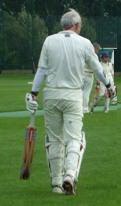As England made a final test victory certain yesterday, Fantasy Bob was among the first to learn that Paul Collingwood's sock would retire from Test cricket. Under its exclusive arrangement with FB, the sock reported that the Sydney Test would be its last. It said, 'Now is the time to ensure some of the younger socks get an opportunity at Test level.'
Tributes to Collingwood's sock have poured in from socks all across the cricketing world. Many commended the fact that the sock made the most of relatively limited skills. In response the sock told FB 'It has been a privilege to be the subject of such patronising comments throughout my 68 Test career.'
FB pays tribute to a fine non-tweeting cricketer and his socks. He may be harder to replace than many commentators imagine.
Collingwood will continue to put the socks on in the shorter forms of the game. The sock will be reporting one final time to Fantasy Bob this weekend.
But before that a digression. Paul Collingwood is not the only great Collingwood to come out of Geordie land. He was preceded some 200 years ago by Vice Admiral Cuthbert Collingwood, 1st Baron Collingwood (1748–1810). History does not report this Collingwood's batting average or how effective he was in the field at backward point. His real claim to fame was as a key colleague to Lord Nelson. He was second in command at Trafalgar as well as a key participant in several of the most important victories during the Napoleonic Test Series.
At Trafalgar, Collingwood commanded the Royal Sovereign. Having drawn considerably ahead of the rest of the fleet, she was the first engaged. "See", said Nelson, pointing to the Royal Sovereign as she penetrated the centre of the enemy's line, "see how that noble fellow Collingwood carries his ship into action!" FB believes that Andrew Strauss said something similar after Paul Collingwood's superb catch to dismiss Ponting during the Perth Test.
Towards the end of his life Collingwood was in the habit of taking long walks around Morpeth his home town. He would carry acorns in his pockets and plant them at every favourable spot thus securing a supply of oak trees for the naval builders. The development of iron and steel ships of course means that many of his oaks are probably still standing.
There is a district in Melbourne named after this naval hero although confused Aussie cricket lovers have long wondered why they sould live in a district named after England's number 5 bat. Hearts of Oak? Test Match Quality.
Tributes to Collingwood's sock have poured in from socks all across the cricketing world. Many commended the fact that the sock made the most of relatively limited skills. In response the sock told FB 'It has been a privilege to be the subject of such patronising comments throughout my 68 Test career.'
FB pays tribute to a fine non-tweeting cricketer and his socks. He may be harder to replace than many commentators imagine.
Collingwood will continue to put the socks on in the shorter forms of the game. The sock will be reporting one final time to Fantasy Bob this weekend.
 |
| Monument to Paul Collingwood at Tynemouth |
At Trafalgar, Collingwood commanded the Royal Sovereign. Having drawn considerably ahead of the rest of the fleet, she was the first engaged. "See", said Nelson, pointing to the Royal Sovereign as she penetrated the centre of the enemy's line, "see how that noble fellow Collingwood carries his ship into action!" FB believes that Andrew Strauss said something similar after Paul Collingwood's superb catch to dismiss Ponting during the Perth Test.
Towards the end of his life Collingwood was in the habit of taking long walks around Morpeth his home town. He would carry acorns in his pockets and plant them at every favourable spot thus securing a supply of oak trees for the naval builders. The development of iron and steel ships of course means that many of his oaks are probably still standing.
There is a district in Melbourne named after this naval hero although confused Aussie cricket lovers have long wondered why they sould live in a district named after England's number 5 bat. Hearts of Oak? Test Match Quality.


No comments:
Post a Comment